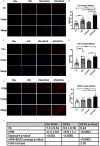Air Pollution Particulate Matter Exposure and Chronic Cerebral Hypoperfusion and Measures of White Matter Injury in a Murine Model
- PMID: 34424052
- PMCID: PMC8382048
- DOI: 10.1289/EHP8792
Air Pollution Particulate Matter Exposure and Chronic Cerebral Hypoperfusion and Measures of White Matter Injury in a Murine Model
Erratum in
-
Erratum: "Air Pollution Particulate Matter Exposure and Chronic Cerebral Hypoperfusion and Measures of White Matter Injury in a Murine Model".Environ Health Perspect. 2024 Feb;132(2):29001. doi: 10.1289/EHP14445. Epub 2024 Feb 15. Environ Health Perspect. 2024. PMID: 38358996 Free PMC article. No abstract available.
Abstract
Background: Exposure to ambient air pollution particulate matter (PM) is associated with increased risk of dementia and accelerated cognitive loss. Vascular contributions to cognitive impairment are well recognized. Chronic cerebral hypoperfusion (CCH) promotes neuroinflammation and blood-brain barrier weakening, which may augment neurotoxic effects of PM.
Objectives: This study examined interactions of nanoscale particulate matter (nPM; fine particulate matter with aerodynamic diameter ) and CCH secondary to bilateral carotid artery stenosis (BCAS) in a murine model to produce white matter injury. Based on other air pollution interactions, we predicted synergies of nPM with BCAS.
Methods: nPM was collected using a particle sampler near a Los Angeles, California, freeway. Mice were exposed to 10 wk of reaerosolized nPM or filtered air (FA) for 150 h. CCH was induced by BCAS surgery. Mice (C57BL/6J males) were randomized to four exposure paradigms: a) FA, b) nPM, c) , and d) . Behavioral outcomes, white matter injury, glial cell activation, inflammation, and oxidative stress were assessed.
Results: The joint group exhibited synergistic effects on white matter injury (2.3× the additive nPM and scores) with greater loss of corpus callosum volume on T2 magnetic resonance imaging (MRI) (30% smaller than FA group). Histochemical analyses suggested potential microglial-specific inflammatory responses with synergistic effects on corpus callosum C5 immunofluorescent density and whole brain nitrate concentrations (2.1× and 3.9× the additive nPM and effects, respectively) in the joint exposure group. Transcriptomic responses (RNA-Seq) showed greater impact of than individual additive effects, consistent with changes in proinflammatory pathways. Although nPM exposure alone did not alter working memory, the cohort demonstrated impaired working memory when compared to the group.
Discussion: Our data suggest that nPM and CCH contribute to white matter injury in a synergistic manner in a mouse model. Adverse neurological effects may be aggravated in a susceptible population exposed to air pollution. https://doi.org/10.1289/EHP8792.
Figures








Comment in
-
Breaching the Barrier: Nanoscale Particulate Matter and Measures of Brain Health.Environ Health Perspect. 2021 Dec;129(12):124003. doi: 10.1289/EHP10319. Epub 2021 Dec 28. Environ Health Perspect. 2021. PMID: 34962425 Free PMC article.
References
-
- Allen JL, Oberdorster G, Morris-Schaffer K, Wong C, Klocke C, Sobolewski M, et al. . 2017. Developmental neurotoxicity of inhaled ambient ultrafine particle air pollution: parallels with neuropathological and behavioral features of autism and other neurodevelopmental disorders. Neurotoxicology 59:140–154, PMID: , 10.1016/j.neuro.2015.12.014. - DOI - PMC - PubMed
-
- Benedictus MR, Binnewijzend MAA, Kuijer JPA, Steenwijk MD, Versteeg A, Vrenken H, et al. . 2014. Brain volume and white matter hyperintensities as determinants of cerebral blood flow in Alzheimer’s disease. Neurobiology of Aging 35(12):2665–2670, PMID: , 10.1016/j.neurobiolaging.2014.06.001. - DOI - PubMed
Publication types
MeSH terms
Substances
Grants and funding
LinkOut - more resources
Full Text Sources
Medical
Miscellaneous

